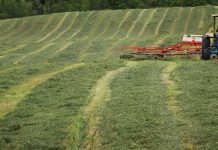Once you collect a representative sample from a batch of manure (subject matter for another time) and submit it to a laboratory for analysis … and get the results of that analysis, it is pretty easy to calculate the value of the fertilizer nutrients in that manure.
You’ll likely be impressed by the dollar value you calculate, but that is not likely the value of manure you apply to your fields. Determining the real value of manure on your farm is a lot more complicated than that.
Manure has value when applied to crop production soils. The greatest benefit is that it is a source of nitrogen, phosphorous, potassium, and a number of micro-nutrients that are required for growing crops.
Manure brings improvements in soil structure and soil quality that can significantly enhance crop yields. The requisite to attaining manure value is that it is retained and incorporated into the soil, where it’s nutrients are available for soil organisms and uptake by plant roots.
Site selection
This is especially problematic when winter manure applications are made on frozen or snow-covered sites. Care must be taken to choose sites with little or no slope and have a good vegetative cover for wintertime applications.
During the growing season, runoff issues are also in play when heavy rainfall events may wash manure (and its nutrients) off the application sites … worst case, into nearby streams.
Growing season manure applications will lose most of the ammonium-N unless the manure is soil-incorporated during (or soon after application). An exception to this rule is that feedlot and solid manures have low levels of ammonium-N and may not incur significant value from incorporation.
It is also notable that manure nitrogen applications that exceed crop N requirements will likely result in the excess nitrogen leaching from the crop root zone and be lost (a nitrogen scavenging cover crop may offset this loss … but that too is a subject for another time.)
The bottom line is that the value of manure is lessened to the extent that you are unable to retain manure, and its nutrients, on the application site for current or future crop use.
Aside from your efforts to assure that manure and its included nutrients are retained on/in your crop soils, you can gain most value by careful selection of the fields where manure will be applied.
Application advice
Greatest benefit and crop response will come when manure is applied to sites that are low in phosphorous (Bray P1 levels below 30 ppm). While not likely to bring as much yield boost as low phosphorous sites, targeting fields that need additional potassium will offer additional value.
Efforts to maximize the value of your livestock manure applications will involve development and execution of a comprehensive plan.
That plan needs to involve:
1. Storage of manure in a manner that reduces nutrient losses.
2. Manure nutrient testing.
3. Soil testing.
4. Prioritize manure applications to sites where benefits are maximized.
5. Control applications to achieve uniform application at the desired rate.
6. Choose application sites and times that minimize losses from runoff.
7. Incorporate slurry and liquid manures into the soil to minimize ammonium -n losses.
8. Don’t apply excess n and use scavenging cover crops to reduce n losses due to leaching.
9. Map fields and keep records of manure application sources, sites, and application rates.
Contact your county Soil and Water Conservation District to get help developing the manure management plan that enables optimization of manure value on your farm. Readers of this article may correctly accuse that I’ve not answered the question that I posed at the onset. What I’ll offer is that manure applications will achieve significant remuneration to your farm operation if you are able to get the nutrients into the soil and keep them there for use by soil organisms and your crop plants.
Remuneration will come in the form of elevated yields and possibly improved crop quality, especially forages. These returns are measurable and can be valued.
And finally, you can add the savings from commercial fertilizers you do not need to purchase. You’ll be amazed at what it is worth if you are able to save the ammonium nitrogen, in the manure, for crop production — rather than allowing it to evaporate into the air.
Likewise, efforts to keep the phosphorous, potash and micronutrients from washing off the soil will be well rewarded.














I have a pile which is going to be almost 12 months old when I will use it. Does waiting such time negatively affect the final compost product?